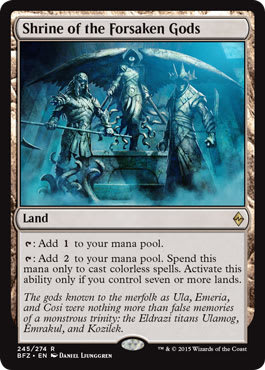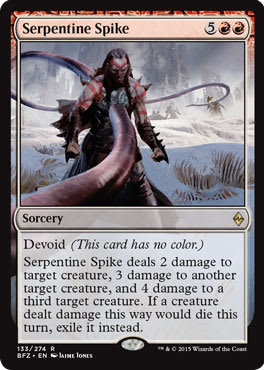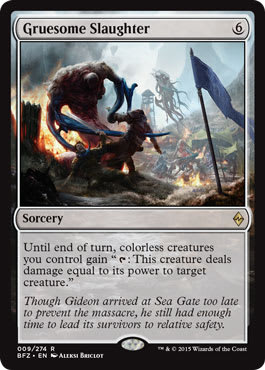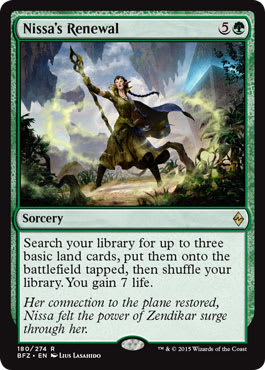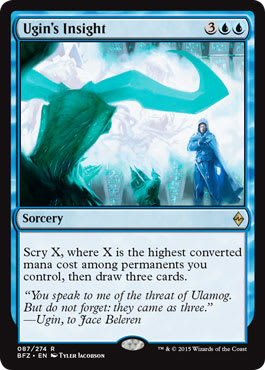It's time for another rendition of my “Snacks with” article mini-series in which I sit down with members of the Vorthos community and grill them with questions over snacks.
Well, it’s more like over e-mail, but if it were possible, I would totally meet these fine creative folk and talk shop over some delicious plates of okra, Twinkies, and tofu. So far, we have gotten to know resident community Oracle Cary Barkett and Wizards of the Coast creative team member Ari Levitch.
Battle for Zendikar is here. Like it or not, Ulamog’s brood is in full force, sweeping across our favorite plane with an insatiable hunger. Today, we sit down with another member of the creative team at Wizards of the Coast, one who was deeply involved with our third planar return . . .

Seek the Wilds | Art by Anna Steinbauer
Tell us a little bit about yourself. Who are you, and what is your current position?
 I’m a creative designer on the story team in Magic R&D. Our team plans out the story, develops characters and worlds (along with the art team), writes Uncharted Realms, makes sure the cards have names and flavor text, and writes art descriptions.
I’m a creative designer on the story team in Magic R&D. Our team plans out the story, develops characters and worlds (along with the art team), writes Uncharted Realms, makes sure the cards have names and flavor text, and writes art descriptions.
As for who I am, really, I’m a kid who always loved Magic and speculative fiction, and I was mind-bogglingly fortunate enough to wind up getting to make Magic’s fictional worlds and stories for a living.
What did you used to do before you became a Wizard of the Coast?
You can hear my full origin story, at least up until a few years ago, in a podcast interview with Rich Hagon, which you can download here.
But basically, I was working as an editor and writing for StarCityGames.com, and event coverage manager Greg Collins picked me up to do editing for the Pro Tour (I believe after a tip-off from Ted Knutson, then the editor at StarCity). Most of my StarCity articles were flavor/humor stuff—a bit prophetic, looking back, and certainly indicative of my interests.
Once I was inside the building, I bounced around a bit, mostly in a good way. I started in R&D splitting my time between editing cards and the website, moved over to the website full time, ran Daily MTG for several years, and then moved back to R&D as a card editor when senior editor Del Laugel tagged me to come back. I hadn’t been planning on moving over to the story team, but as I worked with the writers in my editing capacity and saw the big shift in story coming up and the cool stuff they had in store, I realized I wanted to be a part of it. Del and the rest of R&D leadership, including story team manager Jenna Helland, were very supportive, and after a six-month trial run, I moved over to creative full-time.
What was your position title on the Battle for Zendikar team? What were your responsibilities?
I didn’t work at all on the worldbuilding for BFZ—I was on the story team for most of it, but assigned to other stuff—but once it came time to execute on the set itself, I was in it up to my eyeballs.
I was the creative liaison on the development team, so I worked to make sure the creative vision for the set came through in the final execution in addition to serving as a regular dev team member—play-testing, going to meetings, etc.
My biggest role on the set, in terms of time and effort, was what we call lead concepter, the person who writes the art descriptions. I wrote the majority of the art descriptions for the set, with others pitching in a few (notably, Ari Levitch wrote most of the legends). I was also the creative text coordinator, running a team of external contractors to generate the names and flavor text for the finished cards.
Writing art descriptions wasn’t really on my radar when I moved over to the story team, but it has turned out to be one of my favorite parts of the job. I get to go to some of the world’s top fantasy illustrators and tell them, “Hey, I want you to draw this thing I thought of!” Sketch day, when the artists’ initial sketches start coming in, is fun every time, but it’s absolutely incredible when you’re the one who wrote the art descriptions to see how these amazing artists took a vague idea in your head and turned it into gorgeous reality.
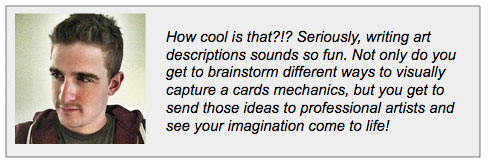
What was your mindset going into the set? Were you nervous/excited/both/neither?
I was nervous, certainly. This was my first major creative lead, and Eldrazi are really weird. I had previously concepted a few cards from Vintage Masters, including Christopher Moeller’s gorgeous Bazaar of Baghdad, and I’d already worked ahead and done the new cards in Commander (2015 Edition), but this was just on a totally different scale. I was excited, too, at the chance to return to such a beautiful and iconic setting.
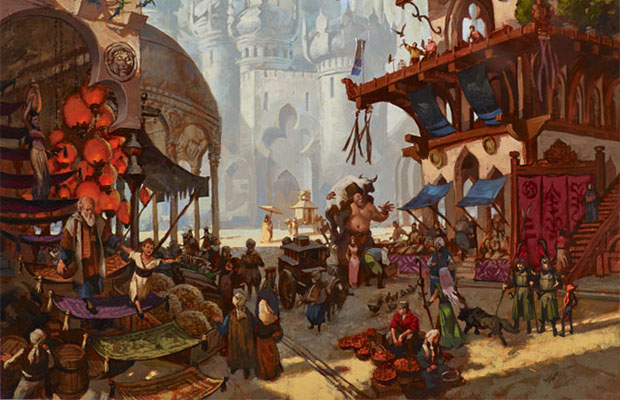
Bazaar of Baghdad | Art by Christopher Moeller
What individual goals did you have for this set?
I wanted to bring across the story, find opportunities for nods to the original Zendikar where appropriate, and take full advantage of the excellent work done by the concept artists. Mostly, though, I just wanted to get it done!
What is your favorite card in the set (based solely on flavor)?
Shrine of the Forsaken Gods is my favorite as a total package.
I’m really interested in religion in fantasy, and Magic has always had a unique take on it. Gods in Magic virtually always turn out to be false, monstrous, or, as in the case of the Eldrazi, both. So the religious aspect of the Zendikar backstory—that the merfolk and kor worshiped gods who were based on dim memories of the Eldrazi titans—has always fascinated me.
When I saw this card in the file, with its mechanical riff on Temple of the False God, I realized that it was a chance to do something we hadn’t: to actually illustrate that relationship between the gods and the titans. I wanted to see our first depictions of the three merfolk gods, and I wanted them to work on their own as humanoid figures while hinting at characteristics of the three titans. I knew that was asking a lot of whoever ended up illustrating the piece, and Daniel Ljunggren delivered spectacularly.
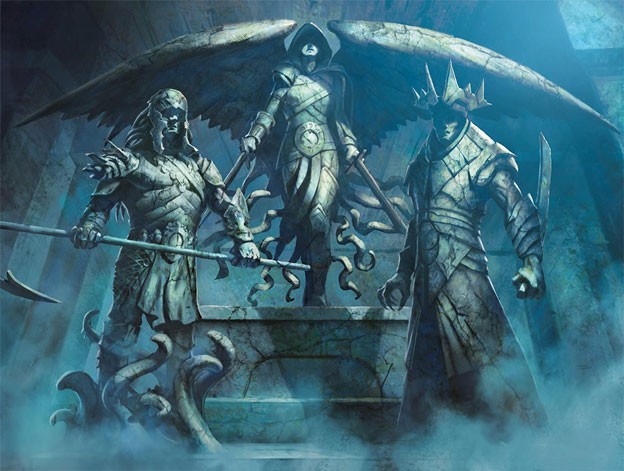
Card and Art © Wizards of the Coast LLC. Images used with permission Shrine of the Forsaken Gods | Art by Daniel Ljunggren
It was really gratifying, when the card was previewed, to see people who aren’t hardcore Vorthoses have that “Whoa!” moment when they figured out what the art was really depicting. Many of them didn’t know about the titan-god connection at all.
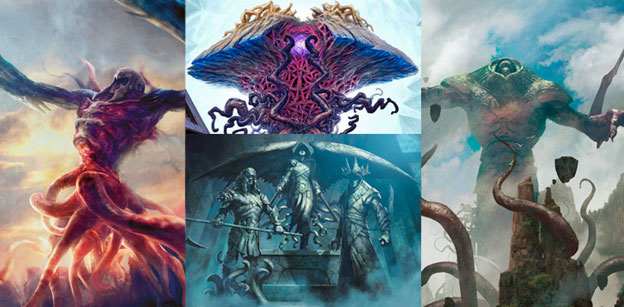
I gave the card really straightforward flavor text because I wanted to make the card as accessible as possible to people who didn’t already know what was going on with the titans and the gods. Absent that constraint, I would have picked this piece, which I love:
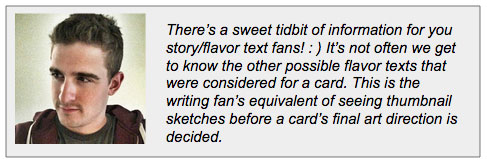
Give us a brief idea of your creative process. What's it like to be inside the head of Kelly Digges while he is hard at work on a set?
I have ADD, so being inside my head while I’m trying to focus on something can be frustrating. There’s a lot of avoidance—I can actually feel my attention sliding off of something in this very slippery, unpleasant way. A lot of the general wisdom about productivity falls flat for me, so I’ve had to work out my own tricks. For example, I find that multitasking actually boosts my output significantly. When I’m working on a couple different things—which is always—I’ll have two or three of them open on my desktop at once, so that when my attention slides, I can slide it over to a different productive task rather than just letting my mind wander. So I might have Battle for Zendikar art descriptions open in one tab, an Uncharted Realms story open in another, and worldbuilding writing for an upcoming set open in a third. (If you don’t have ADD, I can’t recommend this method.)
When I write art descriptions for a set, I usually do the easy ones first. That’s probably backward, but it works for me. I do a sweep through the file, skipping all the ones that seem hard so I don’t get bogged down. Then I go back and do another, slower sweep, picking up most of what’s left. By the time my deadline rolls around, if all goes well, all that’s left are the really hard ones, so I spend the last few days banging my head against those. All according to plan.
Because of this process, the last art description I wrote during the regular BFZ art cycle was Serpentine Spike. The mechanical idea was “Eldrazi Cone of Flame,” but Eldrazi are very physical—their noncreature cards tend to show them doing things with their bodies, not literally casting spells. Even once I’d come up with the idea of this snaking spiked tentacle, it takes extra time to write a complicated concept like that in a way that will still result in an appealing illustration.
For story and worldbuilding work, I’ll often take a walk when I’m feeling stuck. But art descriptions are hard to work on when you’re not staring at them. Occasionally, when I’m down to a few really tricky ones, I’ll take a walk and mull them over. Prior to that point, there are so many of them that there’s not much to do except wade in and start writing them.
No matter what I’m working on, I’ll often turn to my colleagues on the story and art teams for brainstorming—something all of us do with some regularity to get unstuck.
Are you constantly thinking about ideas for Magic stories, characters, and worlds, or are you able to “switch off” the creativity brain when you get home?
Constantly. Constantly. I actually had to wrap up a long roleplaying campaign that I was running after I joined the story team because the time I’d been spending on walks or in the shower thinking about that world were increasingly taken up with Magic stuff. I suppose you’d call that “work,” although it generally doesn’t feel like it.
The thing is, that’s not some unfortunate byproduct of being on the story team. It is, at least for me, a necessary part of the job—partly because you’ve got to be so invested in the world and characters that they won’t get out of your head, and partly because creative work doesn’t happen only when you’re working. Sometimes, your mind needs to wander and unrelated things need to crash together. I know it’s the same way with many of the card designers. I suspect it’s that way for any knowledge work that’s sufficiently wormed its way into your brain—I knew someone who had brilliant editing insights in the shower, which I’ll admit never happened to me.
What were some things that served as inspiration for you when working on this set? Movies, TV shows you watched, or books you read? Works of art or music?
I tend not to turn to fiction for inspiration to write fiction—too much chance of being derivative. Mostly, I looked through the previous Zendikar block for inspiration, as well as the Battle for Zendikar world guide. We pulled a number of characters and ideas forward from the original block, which I’m really happy about.
I did have one song that I listened to on repeat while writing art descriptions: “Intriguing Possibilities” from the soundtrack to The Social Network. Not a song that was remotely on my radar, or one that has anything to do with Zendikar, or that I even particularly like—it’s just something I stumbled across that had the right amount of white-noisiness to block out distractions.
We are moving into a new age of storytelling. Tell us more about the five story moment cards and how they tie into the continuous Uncharted Realms story.
The current story team wants to tell a great story to as many Magic fans as possible. Part of that was ending the novel line and telling the entire story in our weekly Uncharted Realms column, a move that’s been well received and really exciting for us. Another part is making sure that you have some idea of what’s going on in the story even if, like many Magic fans, all you ever look at is the cards.
Although the story of Battle for Zendikar unfolds across many cards, including Planeswalkers and legendary creatures, there are five cards in the set that depict key story events. They’re summarized in the Player’s Guide found in Fat Packs. Those cards are Gruesome Slaughter, Nissa's Renewal, Ugin's Insight, Outnumber, and Aligned Hedron Network, in that order.
Those five cards show a little of the story, and the Player’s Guide lays out a bit more. So in a sense, Aligned Hedron Network is a “spoiler” for the story—at some point toward the end of the Battle for Zendikar story, Ulamog finds himself trapped within a ring of hedrons. But that’s hardly all there is to know. Who put him there? Are they trapping him or killing him? Is it really the end for Ulamog? And . . . what about that whole other set we’re releasing in the block, the upcoming Oath of the Gatewatch? For all that, you’ll have to follow Uncharted Realms. You can find all the stories as they’re released at BattleforZendikar.com, on the story tab.
What type of Planeswalker are you? Do you sling fireballs or summon giant behemoths?
Giant behemoths, all the way. Kiora and I are best buds.

















